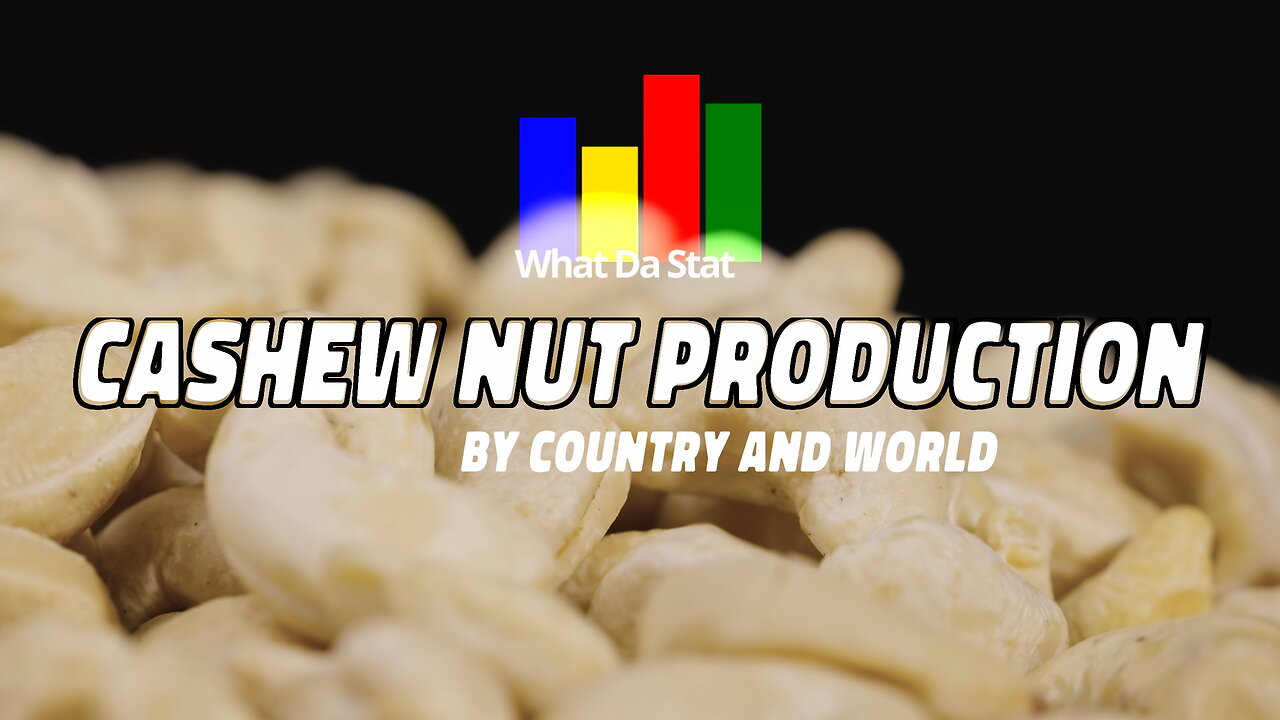Premium Only Content

Cashew Nuts Production by Country and World since 1961
This bar chart race shows cashew nuts production by country and world since 1961, measured in metric tonnes.
Cashew nut production has witnessed remarkable growth since 1961, evolving into a major global industry. The journey of cashew nuts, scientifically known as Anacardium occidentale, has been marked by shifts in production patterns, geographical expansions, and socioeconomic implications.
In the early 1960s, cashew production was concentrated in a few tropical countries, primarily in South America, Africa, and Asia. Over the decades, there has been a notable shift in the global distribution of cashew cultivation. While Brazil, Nigeria, India, and Tanzania were among the early players, countries like Vietnam, Ivory Coast, and Indonesia have emerged as key contributors in recent years.
Several factors have fueled this expansion. The adaptability of cashew trees to diverse climates, coupled with their resilience to harsh conditions, has encouraged cultivation in a broader range of regions. Additionally, the growing demand for cashew nuts in international markets, driven by their nutritional value and versatile applications, has incentivized farmers to increase production.
The processing of cashew nuts has also undergone significant changes. Traditionally, processing involved manual labor, but technological advancements have introduced mechanized methods, improving efficiency and output. This shift has not only boosted productivity but has also impacted employment patterns in the industry.
The socioeconomic impact of cashew production is noteworthy. Many cashew-producing regions, especially in sub-Saharan Africa and Southeast Asia, have experienced improved economic conditions due to the cashew industry. The cultivation of cashews has become a vital source of income for smallholder farmers, contributing to poverty alleviation and rural development.
Despite these positive trends, challenges persist. The industry is vulnerable to price fluctuations influenced by global market dynamics. Issues such as pests and diseases also pose threats to cashew production. Sustainable practices and initiatives aimed at addressing these challenges have gained traction, emphasizing the need for a balanced approach to ensure the long-term viability of the cashew industry.
In conclusion, the global cashew nut production landscape has transformed significantly since 1961. From its concentrated origins to a widespread, economically impactful industry, cashew cultivation has evolved with changing times. The challenges faced by the sector underscore the importance of sustainable practices and international cooperation to secure the future of this versatile and economically significant nut.
Data source: FAO
Data visualization created with flourish.studio
-
 LIVE
LIVE
The Shannon Joy Show
2 hours ago🔥🔥The Roots Of Technocracy EXPOSED. Dark Enlightenment & The Game B Techno-Beast. Top Experts Patrick Wood, Courtenay Turner & Joe Allen LIVE & Exclusive! 🔥🔥
206 watching -
 LIVE
LIVE
Grant Stinchfield
1 hour agoLawyers, Lies & Deleted Tweets: The Russia Hoax House of Cards Is Collapsing
96 watching -
 21:51
21:51
Tudor Dixon
2 hours agoMarsha Blackburn on Ending DEI & Fighting Political Indoctrination | The Tudor Dixon Podcast
6.94K1 -
 DVR
DVR
Bannons War Room
5 months agoWarRoom Live
30.5M7.47K -
 DVR
DVR
Benny Johnson
2 hours agoD-DAY: BOMBSHELL Release Expected TODAY That Will Change EVERYTHING, Trump Posts Hillary Behind Bars
62.6K57 -
 LIVE
LIVE
JuicyJohns
4 hours ago $1.86 earned🟢#1 REBIRTH PLAYER 10.2+ KD🟢$500 GIVEAWAY
92 watching -

Caleb Hammer
3 hours agoShe Came Here To Cancel Me | Financial Audit
16.2K1 -
 LIVE
LIVE
MYLUNCHBREAK CHANNEL PAGE
3 hours agoExposing It All
743 watching -
 1:22:43
1:22:43
The Big Mig™
6 hours agoA World Without Cancer w/ Expert John A. Richardson Jr.
21.8K14 -
 4:17:18
4:17:18
The Bubba Army
1 day agoTrump Pardoning Diddy? - Bubba the Love Sponge® Show | 7/30/25
54.7K12